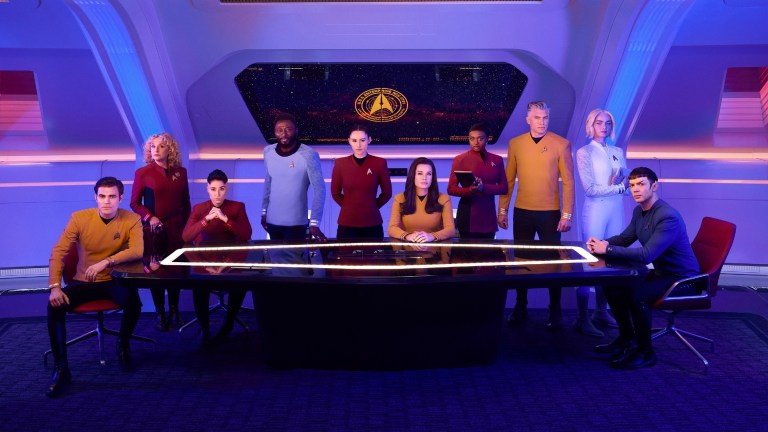Star Trek: The Difference Between the Federation and Starfleet
We know that Captains Kirk and Picard work for Starfleet. Or do they work for the United Federation of Planets? Which is it? What's the difference?

After a long wait, the U.S.S. Enterprise has received a response from the planet Eminiar VII. They had hoped to contact the planet and establish diplomatic relations with the inhabitants in the star cluster. But the message they receive in return is simple: stay away.
When Kirk gets that reply, he intends to respects their wishes. But no sooner does he order the Enterprise to change course than a man arrives on the bridge and overrides Kirk. This moment must have shocked the first viewers of “A Taste of Armageddon” from the first season of The Original Series of Star Trek. After all, who could override the Captain on his own ship?
The answer is the United Federation of Planets, for whom the man, Ambassador Robert Fox (Gene Lyons), works. Although “A Taste of Armageddon” aired in 1967, the distinction between Starfleet and the Federation still confuses viewers today. So what is the difference between the Federation and Starfleet?
The simple answer is this: the United Federation of Planets is a galactic government founded by humans, Vulcans, Andorians, and Tellarites. By the time of Star Trek: The Next Generation, the Federation contained over 150 member worlds. Starfleet is a branch of the Federation, devoted to exploration and defense. But the two organizations have a long and fascinating history that reveals a much more complex working relationship.
How Starfleet Took Flight
In the earliest episodes of TOS, Kirk identified several different organizations as the source of his authority, including United Earth Space Probe Agency, Space Central, Star Service, and Spacefleet Command. The term Starfleet doesn’t show up until “Court Martial” in season one.
Starfleet’s primary mission is the one that Captains Kirk, Picard, and Pike describe at the start of their respective TV shows. Starfleet searches the galaxy for new forms of life and new civilizations, in the name of peace and the gaining of knowledge.
At least, that’s the idea. However, the various Star Trek shows and movies also feature a lot of shooting. That’s because Starfleet is responsible for the Federation’s military actions as well. The balance between peaceful exploration and military function has always been blurry in Star Trek history, as demonstrated in the franchise’s first two movies.
In Star Trek: The Motion Picture, the Enterprise spends all of its time investigating the V’Ger probe, a contemplative mission performed by a crew wearing pastel pajamas. For the sequel, Star Trek II: The Wrath of Khan, Trek creator Gene Roddenberry was pushed to the background and the studio brought in director Nicholas Meyer. Meyer saw Starfleet as a military organization, and thus shot the film like a submarine warfare movie and gave the crew more military-like uniforms.
The tonal differences between these two movies capture the tension at the heart of Star Trek. As much as the characters describe their mission in terms of peaceful exploration, the writers and directors haven’t always succeeded in making that look exciting. It’s much easier to give the characters standard adventures, in which they shoot laser guns and do two-handed chops onto the backs of aliens.
The prequel series Star Trek: Enterprise does a nice job working that tension into the show’s overall plot. Set 100 years before TOS, Enterprise follows Starfleet’s first deep space mission, aboard the Enterprise NX-01, under the command of Captain Jonathan Archer. Although the mission began focused on exploration, starting with returning a waylaid Klingon back to Qo’noS, it soon became enmeshed in larger conflicts, especially the Xindi War. During that conflict, Starfleet served as Earth’s defense against the Xindi, which necessitated putting combat before exploration.
Founding the United Federation of Planets
While “A Taste of Armageddon” first introduced the world to the Federation, Star Trek: Enterprise traces the actual in-universe founding of the Federation. Initially, Earth learned about life on other planets after Vulcans noticed Zefram Cochrane take humanity’s first Warp-driven flight, as depicted in Star Trek: First Contact. From that event, dubbed First Contact Day, the Vulcans guided humanity’s first steps into deep space. But not every human liked that Vulcan oversight, especially not Captain Archer, who held the Vulcans responsible for problems in his father’s career.
Things only grew worse when the NX-01 got involved in a conflict between the Vulcans and the Andorians, one that led humanity to meet Andoria’s other rival, the Tellarites. While the four species squabbled regularly, they came together during the Babel Crisis. The Romulan Star Empire used a drone disguised as an Andorian ship, hoping to put the four worlds at war with one another. Instead, Earth, Vulcan, Andoria, and Tellar worked together to dispel the Romulan threat, a project that led to talks of a Coalition of Planets.
The first Coalition conference included the four primary planets, as well as dignitaries from Denobula, Coridan, Ktaris, Rigel V, and others. An attack from the human terrorist group Terra Prime disrupted the Coalition conference, but the actions of Archer and his crew convinced the other planets to continue the talks. Six years later, the four primary planets formed the United Federation of Planets.
The Federation tends to be an aspirational organization. However, it must also be recognized as a political organization, which makes it attractive to schemers. Where Starfleet gets some terrible Admirals, the Federation can get weak leaders such as President Jaresh-Inyo, who is immediately overwhelmed by the Dominion war in Deep Space Nine. However, we have seen evidence of more competent Presidents, such as Laira Rillak on Discovery, whose work rebuilding the Federation has left her with no patience for Michael Burnham’s shenanigans.
To Boldly Imagine
So, the Federation and Starfleet aren’t exactly separate institutions. Rather, their mission and functions bleed into one another on a regular basis. It’s easy to see why newcomers get confused and longtime fans seem to use the terms interchangeably.
However, the Federation and Starfleet also represent Star Trek‘s fundamentally optimistic worldview. Star Trek believes that humanity is fundamentally good, and that we can overcome racism, capitalism, sexism, homophobia, and all other forms of division to work together. And when we work together, we can go farther than we ever dreamed.
Simply put, the Federation shows us how we can come together, and Starfleet shows what we can accomplish, boldly going where no one has gone before.
